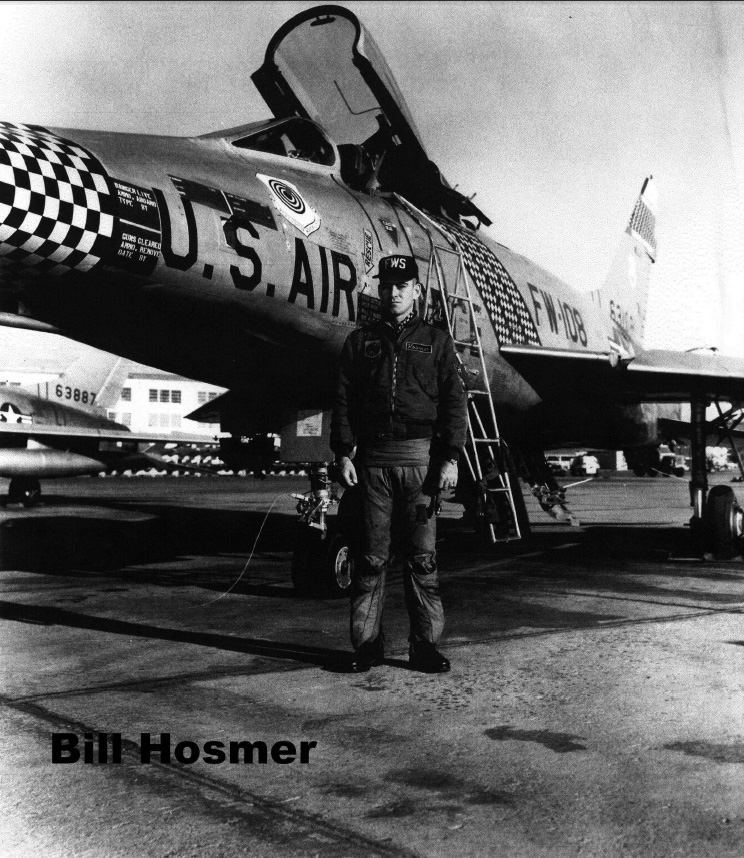“I flew the F-100A at Nellis in 1957 and was an IP in it (also the C, D, and F). I Got nearly 3000 hours in all models, including a combat assignment at Ty Hoa AB, Vietnam in ‘1969-‘1970.
My military time was mostly single-engine, single-seat fighters, and attack birds. I had a wonderful time of it and flew with fighter pilots that showed me what that business is all about. I am thankful for the opportunity to be associated with those who shared my love for what we did, and in most cases, how we did it. Check Six!”
Bill Hosmer’s awards and decorations include :The Silver Star, for action while flying the F-105 in 1965 over North Vietnam, DFC for a flight where his wingman was shot down along with five others on the first raid against SAM Sites in North Vietnam. Two of the pilots were killed in a mid-air collision while checking each other for battle damage over Thailand. His wingman, Frank Tullo, was the only one picked up that day, two more were taken prisoner after being shot down.
Bill also received the Bronze Star for a mission in the F-100 at Tuy Hoa in 1970. He completed a successful mission attacking a large number of workers repairing a road in Laos that had been bombed out earlier. The Misty FAC estimated that my wingman and I caused an estimated 300 to 400 Killed by air. For this, he was awarded the Legion of Merit.
To read more about Bill, see the article at Riding the thunder: North Dakota’s ‘Hoz’ made mark as elite pilot, combat leader
Bill Hosmer – Caterpillar Story
 In 1961, I was Thunderbird Two (Left Wing) on a flight from Wright-Patterson AFB to Quonset Point NAS, Rhode Island. Hoot Gibson, the Leader then, had received clearance from the tower there for arrival maneuvers prior to landing for a demonstration the next day.
In 1961, I was Thunderbird Two (Left Wing) on a flight from Wright-Patterson AFB to Quonset Point NAS, Rhode Island. Hoot Gibson, the Leader then, had received clearance from the tower there for arrival maneuvers prior to landing for a demonstration the next day.
As we closed up formation and descended for the initial maneuver, I started to fall back. Additional throttle did nothing, so I called to say I had a problem and used speed to get some altitude. We were fairly close to the runway, but I zoomed to an altitude close to what would allow me to reach a low-key point on a downwind.
I attempted air starts with no luck. Bob Cass, Thunderbird Three (Right Wing), peeled off and onto a wide wing formation on me, and talked me through another attempted air start, but still no luck. While attempting the air starts, I was not concentrating sufficiently on my positioning and my altitude was not looking good for a successful landing, especially when I put the gear down. Bob Cass, with fervor, told me to get out, so I rolled out of my turn from downwind to base, aimed at an uninhabited area straight ahead, and ejected.
I estimate I was around 500 to 600 feet above the ground in my descent. The seat separation was fine, the canopy looked great, but I was right over a busy roadway, and it looked as though I’d be run over by a car if I landed on the road. I pulled on one side of the chute to slip off the roadway line and promptly found myself in a rather tall tree adjacent to the asphalt. I heard my F-100C’s impact just before I became tangled in the branches. I felt that I had no apparent injuries, but it took me a while to disentangle from the tree, which was not an easy one to climb down. A lot of the auto traffic stopped and people came to my tree to offer assistance. I told them just to let me try it, and to back away so neither I nor my equipment would fall on them. (I really wished no one was there because I needed to urinate.) I made my way down successfully and was given a ten-minute ride to the front gate of the base, where I was picked up by some of our maintenance guys. They drove me to the flight line where the troops were watching this arrival demonstration. Swell. I had no major injuries, and the next day we flew our airshow, with me using the spare F-100C which was brought along for our events.
I left the team in mid-1963 with no more incidents of this kind. The Hun had notorious electrical difficulties which involved the main fuel shut-off valve, and that was the suspected reason for my engine failure. There were skeptics in the Nellis leadership about that finding. Fortunately, later on, while we were flying to Florida at cruising altitude, and passing over Alabama, Hoot Gibson experienced flame-out while at cruising altitude, probably above 35,000 feet.
When he reached the altitude in the descent at which air starts were deemed successful (around 25,000 feet), he began a series of air start attempts as we approached Maxwell AFB, AL. He descended through several decks of clouds while continuing air start attempts to no avail. Hoot picked up the field visually and performed a perfect dead stick landing. I don’t recall the length of that runway, but the F-100C had no flaps, so his touchdown speed was high. It was a “storybook” landing. The findings on Hoot’s engine failure were the same as what was suspected in my accident and alleviated the skepticism I had faced earlier.
Note: I went from the team to F-105s in Okinawa and Korat RTAFB, a tour at TAC HQ, thence to Tuy Hoa (back in the Hun) and later into the A-7D at DM AFB AZ. No more ejections!








